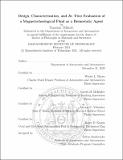Design, characterization, and In vivo evaluation of a magnetorheological fluid as a hemostatic agent
Author(s)
Tekleab, Yonatan.
Download1251896417-MIT.pdf (41.75Mb)
Other Contributors
Massachusetts Institute of Technology. Department of Aeronautics and Astronautics.
Advisor
Wesley L. Harris, Gareth H. McKinley, George C. Velmahos and Roger D. Kamm.
Terms of use
Metadata
Show full item recordAbstract
Magnetorheological (MR) fluids and elastomers have been shown to be effective in systems requiring responsive materials with fast-acting, tunable properties. Recently, use of MR fluids (MRFs) has risen with improvements in quality and cost of raw materials and manufacturing processes. Traditionally used in automotive and manufacturing industries, these applications have recently extended into healthcare, improving prosthetics and exoskeleton designs. Inspired by such applications, we have developed a magnetically-actuated fluidic valve using a biocompatible MRF suspension for use in the human body, to slow hemorrhage. Traumatic injury is the leading cause of death in the United States and globally for people of ages 1 - 46, 30% to 40% of which are attributed to severe or prolonged hemorrhage. Furthermore, 80% of trauma-related deaths in the first hour of hospital admission are due to hemorrhagic shock. Field-responsive, biocompatible suspensions present a unique opportunity to intervene in pre- and early hospital settings to stem thoracic and abdominal bleeding. Such a hemostat would provide physicians more time to resuscitate patients upon trauma facility admission. The MR valve comprises an injectable, biocompatible MRF suspension with externally placed permanent magnets. To produce a significant, controllable MR effect in a bleeding patient near the site of injury, the MRF was designed for biocompatibility, rapid delivery, and spatially localized actuation within blood vessels such that bleeding can be controlled. Understanding and optimizing the particulate chaining and accumulation mechanisms by which the MRF stems bleeding in situ is critically important. We have synthesized and characterized a novel, biocompatible, MR hemostatic agent for use with hemorrhaging patients through a minimally invasive technique. Safety and efficacy of the technique have been demonstrated through benchtop and preliminary in vivo (rat) models. Using small Neodymium magnets in 3D printed holders that can be worn by field surgeons, we demonstrate arrest of a major hemorrhagic event over a range of physiologically-relevant flow conditions, with sustained blood pressure, dramatically reduced volumes of blood loss, and significantly increased survival time. In future phases, safety and efficacy of the method will be demonstrated in swine models before testing in controlled surgical settings with human patients.
Description
Thesis: Ph. D. in Materials and Structures, Massachusetts Institute of Technology, Department of Aeronautics and Astronautics, February, 2021 Cataloged from the official PDF of thesis. Includes bibliographical references (pages 291-315).
Date issued
2021Department
Massachusetts Institute of Technology. Department of Aeronautics and AstronauticsPublisher
Massachusetts Institute of Technology
Keywords
Aeronautics and Astronautics.